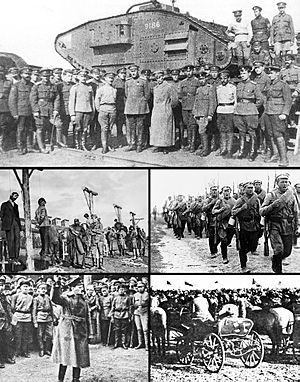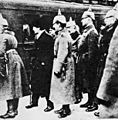Russian Civil War facts for kids
Quick facts for kids Russian Civil War |
|||||||||
|---|---|---|---|---|---|---|---|---|---|
| Part of the aftermath of World War I and the Russian Revolution | |||||||||
 Clockwise from top: Soldiers of the Don Army in 1919; a White infantry division in March 1920; soldiers of the 1st Cavalry Army; Leon Trotsky in 1918; hanging of workers in Yekaterinoslav (Dnipro) by the Austro-Hungarian Army, April 1918. |
|||||||||
|
|||||||||
| Belligerents | |||||||||
|
French volunteers (From 1921) (1919–20) |
Including
Other new republics Including
Allied intervention Including
German-led intervention Including
Other factions
(From March 1918) (From 1919) (1920–21) (1921) Various anti-Soviet factions also fought against each other. |
||||||||
| Commanders and leaders | |||||||||
| Strength | |||||||||
|
Red Army: 5,427,273 (peak) Black Army: 103,000 (peak) |
White Army: 2,400,000 | ||||||||
| Casualties and losses | |||||||||
| ~1,500,000 259,213 killed 60,059 missing 616,605 died of disease/wounds 3,878 died in accidents/self-inflicted deaths 548,857 wounded/frostbitten |
650,000 total casualties | ||||||||
| 7,000,000–12,000,000 combined total casualties, including hundreds of thousands from the White and Red Terrors | |||||||||
The Russian Civil War was a big fight in Russia from November 1917 to October 1922. It happened after World War I and the Russian Revolution. The main groups fighting were the Red Army and the White Army. The Red Army was made up of people who supported communism. The White Army was against them. Other groups also joined the fight, sometimes helping one side.
The Red Army won because they were better organized. They also controlled the most important areas. After their victory, the communists created the Soviet Union in 1922.
Before the war, Russia's ruler, Tsar Nicholas II, had lost his power. The Russian Empire was very unstable. Many different groups formed. Workers and farmers who supported communism joined the Red Army. Those who opposed communism formed the White Army.
In places like Ukraine, some groups formed the Green Army to fight for their own country. Other groups also fought for independence from Russia. Countries like Finland, Poland, Lithuania, Latvia, and Estonia became independent.
Some foreign countries were worried about communism spreading. They helped the White Army fight the communists. This made the war much bigger and it lasted for several years.
Contents
What Caused the Russian Civil War?
The Russian Civil War began because of many problems in Russia. The country had just gone through a big change called the Russian Revolution in 1917. The old ruler, the Tsar, was removed from power.
The Rise of New Ideas
After the Tsar left, different groups wanted to control Russia. One group was the Bolsheviks, led by Vladimir Lenin. They believed in communism, where everyone is equal and the government controls everything. They formed the Red Army.
Another group, the White Army, wanted to bring back the old ways or create a different kind of government. They were against the Bolsheviks.
Fighting for Independence
Many parts of the old Russian Empire wanted to be free. Places like Ukraine, Finland, and Poland fought for their own independence. This added more groups to the conflict.
Outside Help and Worries
Other countries were concerned about the Bolsheviks. They worried that communism would spread to their own lands. So, countries like Britain, Japan, and the United States sent help to the White Army. This made the war even larger.
How the War Was Fought
The Russian Civil War was fought in three main areas: the east, the south, and the northwest. The war had three main periods. Even Vladimir Lenin was surprised by how big the war became.
Early Fights: Small but Many
The first period of the war started soon after the 1917 revolution. Most of the fighting was small, but it happened in many different places. Some foreign countries began helping the White Army during this time.
The Turning Point: 1919
The second period was very important. It lasted from January to November 1919. At first, the White Army was winning in all three main areas. But Leon Trotsky reorganized the Red Army. The Red Army fought back strongly. The White Army suffered huge losses and almost lost its power.
The Final Battles: Crimea
The third and final period of the war involved fighting in Crimea. Many White Army soldiers had gathered there and made their defenses very strong. The Red Army kept fighting them. When the Polish–Soviet War ended, more Red Army soldiers joined the fight in Crimea. This led to the White Army's defeat in November 1920. Some fighting continued against other groups in the Caucasus region into the early 1920s.
The Cost of the War
The Russian Civil War caused a lot of suffering and death.
- About 8 million people died during the war. Around one million of them were Red Army soldiers.
- The White Army and other anti-communists killed at least 50,000 communists.
- Millions more people died from hunger, starvation, and diseases. In areas controlled by the White Army, like Ukraine and southern Russia, many Jews were killed.
What Happened After the War?
Soviet Russia faced huge problems during and after the war.
Food Shortages and People Leaving
In 1920 and 1921, there was very little rain. This caused a terrible famine in 1921. About one million Russians left the country forever. Many of these people were educated and skilled workers.
Economic Problems
The economy was in ruins. Russia's money, the ruble, lost almost all its value. In 1914, 2 rubles could buy one US dollar. By 1920, you needed 1,200 rubles for one US dollar. Experts believe the war cost Soviet Russia around 50 billion rubles.
Factories and farms produced very little. For example, the Soviet Union made only 5% of the cotton and 2% of the iron ore it made in 1913. Overall, production was only about 20% of what it was before the war.
Impact on Farming
Farming was also badly affected. Farms produced only 37% of their normal amount. The number of horses dropped from 35 million in 1916 to 24 million in 1920. The number of cattle also went down, from 58 million to 37 million.
A New Economic Plan
During the war, the Soviet government struggled to manage the country. In March 1921, after the White Army was defeated, Lenin's government changed its economic plan. They stopped the strict "War Communism" policy. Instead, they started the New Economic Policy. This allowed some private farming and businesses, but the government still controlled major banks and industries.
On December 30, 1922, the Soviet Union was officially created. By 1928, the country's production returned to the levels it had before the war. Lenin, however, died in 1924, and Joseph Stalin became the new leader.
The Russian Civil War, along with World War I, had a lasting impact on the new Soviet Union. People remembered the hard times for many years.
Images for kids
-
Admiral Alexander Kolchak (seated) and General Alfred Knox (behind Kolchak) observing military exercise, 1919
-
The Government of South Russia created by Pyotr Wrangel in Sevastopol, 1920
-
Soviet delegation with Leon Trotsky greeted by German officers at Brest-Litovsk, 8 January 1918
-
Admiral Alexander Kolchak reviewing the troops, 1919
-
London Geographical Institute's 1919 map of Europe after the treaties of Brest-Litovsk and Batum and before the treaties of Tartu, Kars, and Riga
-
General Nikolai Yudenich
-
General Pyotr Wrangel in Tsaritsyn, 15 October 1919
-
Beat the Whites with the Red Wedge, a famous Bolshevik Constructivist propaganda poster by artist El Lissitzky uses abstract symbolism to depict the defeat of the Whites by the Red Army.
-
Tambov Rebellion was one of the largest and best-organised peasant rebellions challenging the Bolshevik regime
-
Refugees on flatcars
See also
 In Spanish: Guerra civil rusa para niños
In Spanish: Guerra civil rusa para niños














